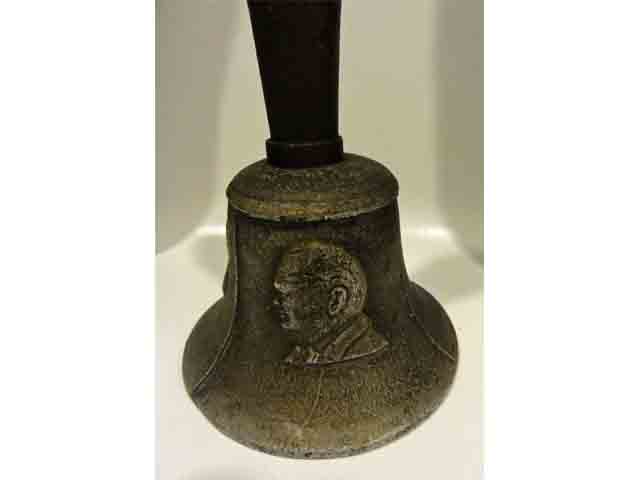On 8th May 2020 it will be 75 years since the guns fell silent at the end of WW2 and life began to return to normal in Southam. It is probably the celebrations on Market Hill and at home that our senior residents will remember most about VE Day. This year the early May Day Bank Holiday has been moved to Friday 8th May to allow people to celebrate the end of the Second World War.
One of the wonderful things about Southam Heritage Collection now being located in Tithe Place, is that people can easily bring in items to show us, that they would like to know more about. Last year one such item came our way to research. It was an unusual hand bell (see picture) that had been found in the possessions of a local gentleman’s father after his death, but no one knew anything about it. It is not a shiny brass bell of the type usually associated with calling children to school, or family to dinner, but a rough cast alloy with a wooden handle, that rang with more of a clatter than a shrill clear ring. In low relief around the bell are depicted four heads, including Churchill, Roosevelt, Stalin and one other, thereby dating it to WW2.
During the war, many German aircraft crashed over the UK. They were all salvaged, stripped of usable parts and their aluminium parts recycled in new aircraft. Any remnants unsuitable for recycling were smelted into ingots and eventually sold. Conrad Parlanti, a London businessman, came from a traditional foundry-casting family and in 1941 he founded his business, the Buckinghamshire Die-Casting Co which still exists today. He came up with the idea of using the ingots to cast hand bells to raise money for the RAF Benevolent Fund and also to maintain the RAF Memorial completed in 1923 for the RAF men who had lost their lives in WW1.
A variety of different hand bell designs were cast and thinking ahead, by the end of the war, the commonest bell he sold had the three heads around it of Churchill, Roosevelt and Stalin with a large letter V on its metal handle, and hence the name ‘Victory Bell’ was adopted. They were sold for around £1. Parlanti’s idea was for people to be able to ring in the peace at the end of the war at a price that was acceptable to the working man.
A battle souvenir associated with the loss of life is perhaps not so acceptable to modern sensibilities, but it is something that has long been a part of war. These include musket balls found and kept after the 17th Century Civil War skirmishes at Southam and Kineton, and engraved trench art made from shell cases found in the French fields during WW1. My son-in-law’s great-grandmother was given a bracelet engraved with her name made from an old shell case while her husband was in the WW1 trenches.
The Victory Bell, such as the one brought into the museum, has perhaps long since lost its background history, just as bells have lost their everyday use and been discarded, there are few remaining – probably hidden away in the dark corners of attics. If you have one in your family, perhaps now is the time to find it and ring in the peace once again.
By Linda Doyle
Our new exhibition opens on Carnival Day at the end of May and will be themed around the development of Southam in the post WW2 era. If you are interested in finding out more about local history, please see our website www.southamheritage.org or visit the museum on Tuesday, Friday and Saturday mornings in Tithe Place. Telephone 01926 613503 email southamheritage@hotmail.com and find us on Facebook.


I have one is it worth anything
Unfortunately Gloria we’re not really in a position to be able to value these items. We don’t really have the experience or skills. Have you tried looking on the internet on eBay or elsewhere to see if you can find anything similar? If you do eventually decide you want to donate it to the Collection we would be happy to have it and also to record the story associated with it.
I have one with Trueman instead of Roosevelts head